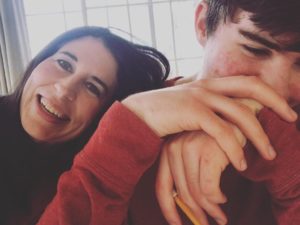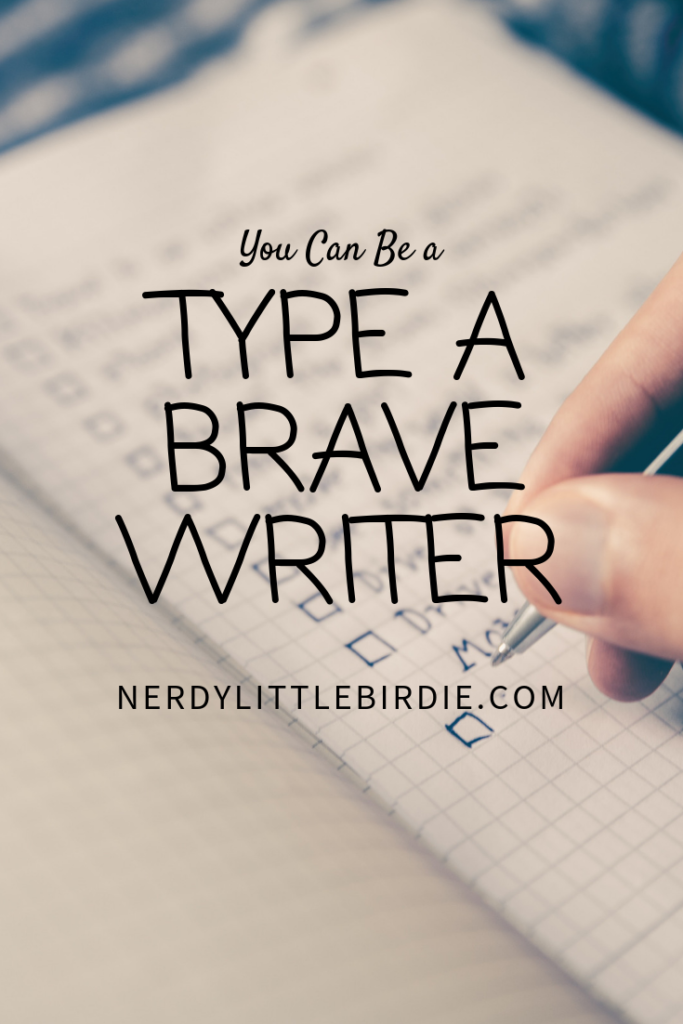Sometimes I hear people say Brave Writer is too Type B for them. Truth be told, I haven’t memorized the exact reasons people give for this. What I have memorized is the slope intercept formula, and I’m still waiting for that brain effort to pay off in my life. But the gist of the Brave Writer complaint, as I understand it, is that it lacks the structure some people need.
I feel ya. Truly.
I like lesson plans and checkboxes. Fight me.
I own a label maker. Sometimes I go all “Sleeping with the Enemy” with it. I freaking love notebook dividers. I hate spiral notebooks because there’s no way to rearrange and organize your notes. The horror! I literally check off my Couch to 5K plan. But then my desk almost always looks like this mess, or this one, or this. Obviously I’m Type A, but I’m not a wackadoodle about it. (Unless you look in my spice cabinet.)
There are a lot of negative associations with being Type A: perfectionism, impatience, uptight, controlling, and always stressed. Who wants to be associated with those characteristics? No one. So I reject that Type A definition and substitute my own.
For me, Type A is about using my organizing skills in a way that supports rather than dictates my kids’ learning.

As someone who blooms best with some structure rather than a lot of open-endedness, guidelines help me wrap my head around a big idea and nudge me in a direction. Seeing a lesson plan, someone else’s idea of X in action, acts as a frame of reference for my own thinking. I see this person’s vision of the BIG IDEA and that helps me envision how that BIG IDEA could look in practice. It’s a springboard into my own imagination, and then I can brainstorm a list (squee!) of how I could tailor it for my kids.
Embracing my Type A side means acknowledging this core trait of wanting some form of a plan before I dive in isn’t changing. If we’re to “welcome our children as they are,” we’d best welcome ourselves as we are too. (The Brave Learner page 1) It’s totally fine if we like a plan before diving in. TOTALLY FINE.
Work with your nature, not against it
So how do you honor this trait and still embrace a Brave Writer approach to homeschooling? Well, try not to be wacky about it. Or at least save your wackadoodle Type A tendencies for something harmless, like your spice cabinet.
But let’s examine that through the lens of teaching your kids writing.
We have this big picture goal of our kids turning into competent writers. BIG goal, yeah? Feels overwhelming and scary, right? It feels that way to me if I don’t have some small, manageable steps to get there.
The flip side to that is if I insist on knowing all of the small steps to get to that BIG goal, that’s overwhelming too. Because there’s no way to see that far into the future. It’s a recipe for anxiety and fear, and fear is what drives us to control our children rather than work with them.
This doesn’t mean we don’t plan. Of course we do! But we plan in the spirit of knowing our kids, of welcoming them as they are. Who they are right now, in this school year, this month, this week, not upon graduation. So plan more for now, not the distant future.
Let’s look at teaching literature too…
After figuring out my son was interested in book themes of freedom, use and abuse of power, and societal degradation (aren’t teens fun?!), I began planning a reading list to fit those themes. That’s the next small step. I don’t have to know how I’ll teach all of them right now. Right now I need to know which texts fall into those themes. After he selects four or five books (our average count for a school year), then I’ll start to plan the teaching side of ONE book. Not all. Just the first book.
And this is where I used to be my own worst enemy, where I’d get in my own way of homeschooling through heart rather than control. I wanted to know all of the steps to point Z ahead of time. If I had this curriculum with steps A-Z preplanned, well, that was security that we’d get to Z! GIVE IT TO ME. Guarantee me we’ll get to Z!
I needed layers of security, and lots and lots of preplanned steps felt like security. But honestly, who doesn’t need security? We all do. But how much? How many layers? Plan A & B are fine. Plan C, hmmm, we’re getting a little into gray areas of control. Plans D, E, F, and G were more about managing my anxieties over the unpredictability of life than being a thoughtful and responsive educator and parent to my boys.

In order to be a more thoughtful and responsive (meaning capable of responding well to changing needs) educator for my kids, I had to wrestle with reducing the layers of security I felt I had to have before I could take that first step. I had to learn to trust Life a little more.
WHAT TO DO: Use your Type A skills to plan and organize that next small step. Maybe the next two. But don’t try to plan in detail the next three, four, and five. Please don’t try to plan an entire high school education in detail! Just plan the next one or two steps.
Relationship first, not the lesson plan
In all of the research I’ve read on teaching and learning (and I loooove to research), when it comes to quality learning, it all circles back to the quality of the relationship between the student and the teacher.
That’s nice to know, but what does have that to do with planning?
You have to keep your relationship with your children first, not the lesson plan.
As the adult you can’t allow rigid adherence to a plan to damage your relationship with your child or their natural way of learning.
“Your relationship with your kids is about presence, not checklists. Who you are and how you behave dictate more than you know.”
The Brave Learner page 40
As a checklist lover, that passage raised questions in my mind.
- How do I behave with the checklist?
- What is the dominate force here, me or the checklist?
- Does my kid have a say in this checklist? The tasks planned within it?
- Which is setting the tone, the energy for our day, me or the checklist?
- How flexible am I with the checklist?

Homeschooling high school, where the stakes are higher and the time to “get it right” is shorter, the checklist takes on a different meaning than when the kids were eight. We now have college admission checklists to consider. These years feel different, absolutely. I feel it; I’m living it right now.
Yet Type A checklisters can still home educate in a way that honors their tendency towards structure while also keeping the relationship with their children at the forefront. This is possible even in high school.
WHAT TO DO: Check your checklist motivations. Ask yourself what’s being prioritized, the checklist or your child? The lesson plan or your relationship? Flexible application or rigid adherence?
Structure or Control?
There is a critical difference separating structure and control. It’s vital that you figure out how to offer structure and routine without it being a cover for controlling your kids or your fears. Are we trying to relieve our anxiety about our kid’s future through the illusion of control?
But we can’t control the future. All we can do is thoughtfully respond to who the children are right now.
There is no formula for figuring out the structure/control equation because each family and child is different. It will take inner reflection on the difference between the two. There is a balance between being directionless and being rigid with direction. There is space in between over-controlling our kids and providing no structure; it’s not an either-or game.
Without a framework or routine, I tend to go directionless and we run into what Julie Bogart calls the wandering nomad problem. No one is really engaged in anything, there’s a lot of couch potato-ing and video gaming going on.
Maybe this happens to you too. This is where your Type A skills at organization, structure and list-making helps. But keep in mind that our adult skills at order and organization shouldn’t supersede our child’s natural way of learning. We use our skills to support their natural learning, not override it.
WHAT TO DO: Use your planning skills as a flexible guide. Offer up positive direction and excitement. Mystery and surprise. Risk and adventure. When the doldrums strike, get to planning one of those. You will get your Type A fix and your kids will get a mom invested in having fun, not in cracking the whip.
But How Do I Schedule Everything in the Brave Writer Lifestyle?
I don’t.
Poetry tea time, writing, narration, art appreciation, literature, board games, copywork, nature journaling, movie watching, read aloud, dictation, morning basket, party school. Whew!
If you can do all those things on a consistently pre-scheduled basis and not lose your mind, you should blog about this and not me. Because I would be in a straight jacket, not able to use my hands to type.
My life isn’t like a regularly scheduled TV program. It’s more like the Breaking News! that interrupts the regularly scheduled program.
My son wants to read books about power, corruption and societies falling apart. Note to self: look into The Tempest, Macbeth, Hamlet and Brave New World. BREAKING NEWS! He now wants to read Don Quixote.
That’s why I plan more along the lines of the One Thing principle. One thing at a time, one or two steps at a time. We’ll still do some Shakespeare. But by not planning out an entire year (or all three plays), I leave room for those BREAKING NEWS! moments.
And I don’t mean this BREAKING NEWS! life as some kind of badge of busyness, as if exhaustion is a status symbol. No. I mean it as in allowing room – actual time and space – for my teens to explore. To not be so hemmed in by curriculum plans that there’s no room for exploring ideas that pop up in life. We can’t expect our teenagers to show signs of self-directed learning if we’re constantly directing them.
Structure with space. That’s what I’m going for.

I throw in a poetry tea time when I can, which I admit is harder with teenage schedules of co-op classes, work and hanging out with friends. We periodically make it to the art museum where I play terrible games with my teens. We’ll watch a book-to-movie after we read the book, like The Princess Bride. I sometimes turn it into a family party school by planning book-themed treats to go along with the movie.
But those are just activities. Don’t use the abundant ways to enact a Brave Writer lifestyle as a means of being so busy that you miss the core of the philosophy, which is a healthy and connected parent-child relationship.
We all have our own bandwidth for busyness. Trying to include every aspect of the BW lifestyle exceeds mine. I do the amount I can do joyfully and graciously. If I’m tipping into stress, I’m doing too much and need to remember it’s the relationship that matters, not the activities. And if I’m frazzled from trying to do every part of the Brave Writer lifestyle, what presence am I bringing to the relationship? To the learning environment?
WHAT TO DO: Do what you can, leave the rest. The different lifestyle activities are ideas to choose from, not mandates to follow. Leave yourself some emotional bandwidth for those BREAKING NEWS! moments of learning.
The True Truth
This is work. There are no preplanned answers when it comes to home educating with the relationship first. We think the solution to homeschool happiness is in a curriculum plan. It’s not.
Channeling my Type A tendencies in a way that’s healthy and relationship-based rather than control-based, it’s hard work at times. Not gonna lie about it. This isn’t how most of society views education, which is more of a top-down hierarchy than a partnership, and we are creatures of our culture. Don’t blame yourself if a dominate cultural attitude affects your frame of reference for how to do something. But that doesn’t mean we have to remain trapped in that attitude either.
It does take inner work to rewire our thinking. It takes concrete steps of leaning into this idea of “following your child as their leader.” (Marie Montessori, as cited in The Brave Learner page 75)
It takes time and energy to pay close enough attention to my kids so that I know who they are and how they work best. It takes me keeping a journal where I write down my observations and ideas.
If checklists help you feel more organized, you get to make them. You are the boss of you! Experiment with how you use them, use them wisely, but don’t feel bad if they’re helpful.
But do remember the checklist is there to serve you, not the other way around.
If you feel drawn to Brave Writer, if its parenting and education philosophy pulls at your heart and you want to take the leap but aren’t sure, what Type A mental factors may be getting in the way of following those feelings? Let’s talk about lingering doubts, the “how to” at high school, and what it means to create structure with space.
Heather
Additional Resources for a Type A Brave Writer
- How I plan with Boomerangs
- Plan a Poe party school
- Throw a bookworm party to select a reading list
- Plan a jack-o’-lantern twist
- Watch Julie’s YouTube video on The Scourge of Perfectionism
- Read The Brave Learner
- The Homeschool Alliance online coaching community
- And I’m working on uploading my personal lesson plans of Help for High School to the blog. I have to add checkboxes to them, omg! Stay tuned.



